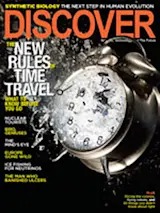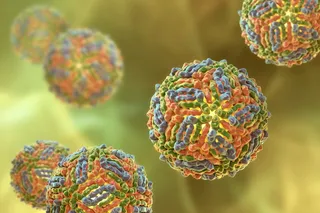For years an obscure doctor hailing from Australia’s hardscrabble west coast watched in horror as ulcer patients fell so ill that many had their stomach removed or bled until they died. That physician, an internist named Barry Marshall, was tormented because he knew there was a simple treatment for ulcers, which at that time afflicted 10 percent of all adults.
In 1981 Marshall began working with Robin Warren, the Royal Perth Hospital pathologist who, two years earlier, discovered the gut could be overrun by hardy, corkscrew-shaped bacteria called Helicobacter pylori. Biopsying ulcer patients and culturing the organisms in the lab, Marshall traced not just ulcers but also stomach cancer to this gut infection. The cure, he realized, was readily available: antibiotics. But mainstream gastroenterologists were dismissive, holding on to the old idea that ulcers were caused by stress.
Unable to make his case in studies with lab mice (because H. pylori affects only primates) and prohibited from experimenting on people, Marshall grew desperate. Finally he ran an experiment on the only human patient he could ethically recruit: himself. He took some H. pylori from the gut of an ailing patient, stirred it into a broth, and drank it.
As the days passed, he developed gastritis, the precursor to an ulcer: He started vomiting, his breath began to stink, and he felt sick and exhausted. Back in the lab, he biopsied his own gut, culturing H. pylori and proving unequivocally that bacteria were the underlying cause of ulcers.
Marshall recently sat down with Discover senior editor Pam Weintraub in a Chicago hotel, wearing blue jeans and drinking bottled water without a trace of Helicobacter. The man The Star once called “the guinea-pig doctor” can now talk about his work with the humor and passion of an outsider who has been vindicated. For their work on H. pylori, Marshall and Warren shared a 2005 Nobel Prize. Today the standard of care for an ulcer is treatment with an antibiotic. And stomach cancer — once one of the most common forms of malignancy — is almost gone from the Western world.
Having rid much of the globe of two dread diseases, Marshall is now turning his old enemy into an ally. As a clinical professor of microbiology at the University of Western Australia, he is working on flu vaccines delivered by brews of weakened Helicobacter. And in an age when many doctors dismiss unexplained conditions as “all in the head,” Marshall’s story serves as both an inspiration and an antidote to hubris in the face of the unknown.
Q: You grew up far from big-city life. What was it like?
A: I was born in Kalgoorlie, a gold mining town about 400 miles east of Perth. My father was a fitter and turner, fixing steam engines and trains. My mother was a nurse. All the miners owed a lot of money and drank a lot of beer, so Mom said, “We’ve got to get out of here before we go the way of everybody else.” In 1951 we headed for Rum Jungle, where a uranium boom was on, but halfway there we stopped in Kaniva, another boomtown, with a whaling station and high-paying jobs. Then my father started managing chicken factories in Perth. We never wanted for anything. It was like the TV show Happy Days.
Q: What sparked your interest in science?
A: My mother had nursing books around. I had three brothers, and we always had electronics and gunpowder and explosions and welding. All I can say is that some things you get from your parents through osmosis. In high school I had Bs and Cs, not too many As, but I must have done well on that medical school test and I must have had some charisma in the interview, so I ended up in medicine. Being a general practitioner was all I aspired to. I was good with patients and very interested in why things happened. Eventually I developed a more mature approach: I realized that at least 50 percent of patients were undiagnosable.
Q: You found yourself confronting unexplainable diseases?
A: In medical school it’s quite possible to get taught that you can diagnose everybody and treat everything. But then you get out in the real world and find that for most patients walking through your door, you have no idea what’s causing their symptoms. You could slice up that person into a trillion molecules and study every one and they’d all be completely normal. I was never satisfied with saying that by ruling out all these diseases, a person must have a fake disease, so I accepted the fact that lots of times I couldn’t reach a fundamental diagnosis, and I kept an open mind.
Q: Is that how you came to rethink the cause of ulcers?
A: Before the 20th century, the ulcer was not a respectable disease. Doctors would say, “You’re under a lot of stress.” Nineteenth-century Europe and America had all these crazy health spas and quack treatments. By the 1880s doctors had developed surgery for ulcers, in which they cut off the bottom of the stomach and reconnected the intestine. We’re pretty certain now that by the start of the 20th century, 100 percent of mankind was infected with Helicobacter pylori, but you can go through your whole life and never have any symptoms.
Q: What was the worst-case scenario for ulcer patients?
A: An ulcer with a hole in it, called a duodenal ulcer, is acutely painful due to stomach acid. When you eat a meal, the food washes the acid away temporarily. When the meal is digested, the acid comes back and covers the raw base of the ulcer, causing pain to start up again. These problems were so common that the Mayo Clinic was built on gastric surgery. After that surgery, half the people would feel better. But about 25 percent of these cured patients became so-called gastric cripples, lacking appetite and never regaining complete health.
Q: With so much physical evidence of a real condition, why were ulcers routinely classified as psychosomatic?
A: Eventually doctors realized they could see the ulcers with X-ray machines, but, of course, those machines were in big cites like New York and London — so doctors in those cities started identifying ulcers in urban businessmen who probably smoked a lot of cigarettes and had a high-pressure lifestyle. Later, scientists induced ulcers in rats by putting them in straitjackets and dropping them in ice water. Then they found they could protect the rats from these stress-based ulcers by giving them antacids. They made the connection between ulcers, stress, and acid without any proper double-blind studies, but it fit in with what everybody thought.
Q: How did you come to challenge this prevailing theory?
A: I was in the third year of my internal medicine training, in 1981, and I had to take on a project. Robin Warren, the hospital pathologist, said he had been seeing these bacteria on biopsies of ulcer and stomach cancer patients for two years, and they were all identical.
Q: What was distinctive about these infections?
A: The microorganisms all had an S-shaped or helical form, and the infections coated the stomach. Warren had found them in about 20 patients who had been sent to him because doctors thought they might have cancer. Instead of cancer, he had found these bacteria. So he gave me the list and said, “Why don’t you look at their case records and see if they’ve got anything wrong with them.” It turned out that one of them, a woman in her forties, had been my patient. She had come in feeling nauseated, with chronic stomach pain. We put her through the usual tests, but nothing showed up. So of course she got sent to a psychiatrist, who put her on an antidepressant. When I saw her on the list, I thought, “This is pretty interesting.”
Then another patient turned up, an old Russian guy who had severe pains. Doctors gave him a diagnosis of angina, pain that occurs when blood to the heart can’t pass through a narrowed artery. It’s rare, but you can theoretically get that in your gut, too. There was no treatment for an 80-year-old man in those days, so we put him on tetracycline and sent him home. He goes off, and two weeks later he comes back. He’s got a spring in his step, he’s practically doing somersaults into the consulting room. He’s healed. Clearing out the infection had cured him. I had one more year to go, so I did the paperwork to set up a proper clinical trial with 100 patients to look for the bacteria causing the gut infection; that started in April of 1982.
Q: But at first nothing was turning up, right?
A: Yes — not until patients 34 and 35, on Easter Tuesday, when I got this excited call from the microbiologist. So I go down there and he shows me two cultures, the grand slam, under the microscope. The lab techs had been throwing the cultures out after two days because with strep, on the first day we may see something, but by the second day it’s covered with contamination and you might as well throw it in the bin. That was the mentality of the lab: Anything that didn’t grow in two days didn’t exist. But Helicobacter is slow-growing, we discovered. After that we let the cultures grow longer and found we had 13 patients with duodenal ulcer, and all of them had the bacteria.
Q: When did you realize H. pylori caused stomach cancer, too?
A: We observed that everybody who got stomach cancer developed it on a background of gastritis, an irritation or inflammation of the stomach lining. Whenever we found a person without Helicobacter, we couldn’t find gastritis, either. So as far as we knew, the only important cause of gastritis was Helicobacter. Therefore, it had to be the most important cause of stomach cancer as well.
Q: How did you get the word out about your discovery?
A: I presented that work at the annual meeting of the Royal Australasian College of Physicians in Perth. That was my first experience of people being totally skeptical. To gastroenterologists, the concept of a germ causing ulcers was like saying that the Earth is flat. After that I realized my paper was going to have difficulty being accepted. You think, “It’s science; it’s got to be accepted.” But it’s not an absolute given. The idea was too weird.
Q: Then you and Robin Warren wrote letters to The Lancet.
A: Robin’s letter described the bacteria and the fact that they were quite common in people. My letter described the history of these bacteria over the past 100 years. We both knew that we were standing at the edge of a fantastic discovery. At the bottom of my letter I said the bacteria were candidates for the cause of ulcers and stomach cancer.
Q: That letter must have provoked an uproar.
A: It didn’t. In fact, our letters were so weird that they almost didn’t get published. By then I was working at a hospital in Fremantle, biopsying every patient who came through the door. I was getting all these patients and couldn’t keep tabs on them, so I tapped all the drug companies to request research funding for a computer. They all wrote back saying how difficult times were and they didn’t have any research money. But they were making a billion dollars a year for the antacid drug Zantac and another billion for Tagamet. You could make a patient feel better by removing the acid. Treated, most patients didn’t die from their ulcer and didn’t need surgery, so it was worth $100 a month per patient, a hell of a lot of money in those days. In America in the 1980s, 2 to 4 percent of the population had Tagamet tablets in their pocket. There was no incentive to find a cure.
Q: But one drug company did provide useful information, right?
A: I got an interesting letter from a company that made an ulcer product called Denel, which contained bismuth — much like Pepto-Bismol in the United States. The company had shown that it healed ulcers just as quickly as Tagamet, even though the acid remained. The weird thing was that if they treated 100 patients with this drug, 30 of them never got their ulcer back, whereas if you stopped Tagamet, 100 percent would get their ulcer back in the next 12 months. So the company said: “This must heal ulcers better than just removing the acid. It must do something to the underlying problem, whatever that is.” They sent me their brochure with “before” and “after” photographs. On the “before” photograph they had Helicobacter in the picture, and in the “after” picture there was none. So I put their drug on Helicobacter and it killed them like you wouldn’t believe. They helped me present at an international microbiology conference in Brussels.
The microbiologists in Brussels loved it, and by March of 1983 I was incredibly confident. During that year Robin and I wrote the full paper. But everything was rejected. Whenever we presented our stuff to gastroenterologists, we got the same campaign of negativism. I had this discovery that could undermine a $3 billion industry, not just the drugs but the entire field of endoscopy. Every gastroenterologist was doing 20 or 30 patients a week who might have ulcers, and 25 percent of them would. Because it was a recurring disease that you could never cure, the patients kept coming back. And here I was handing it on a platter to the infectious-disease guys.
Q: Didn’t infectious-disease researchers support you, at least?
A: They said: “This is important. This is great. We are going to be the new ulcer doctors.” There were lots of people doing the microbiology part. But those papers were diluted by the hundreds of papers on ulcers and acid. It used to drive me crazy.
Q: To move forward you needed solid experimental proof. What obstacles did you encounter?
A: We had been trying to infect animals to see if they would develop ulcers. It all failed; we could not infect pigs or mice or rats. Until we could do these experiments, we would be open to criticism. So I had a plan to do the experiments in humans. It was desperate: I saw people who were almost dying from bleeding ulcers, and I knew all they needed was some antibiotics, but they weren’t my patients. So a patient would sit there bleeding away, taking the acid blockers, and the next morning the bed would be empty. I would ask, “Where did he go?” He’s in the surgical ward; he’s had his stomach removed.
Q: What led up to your most famous and most dangerous experiment, testing your theory on yourself?
A: I had a patient with gastritis. I got the bacteria and cultured them, then worked out which antibiotics could kill his infection in the lab — in this case, bismuth plus metronidazole. I treated the patient and did an endoscopy to make sure his infection was gone. After that I swizzled the organisms around in a cloudy broth and drank it the next morning. My stomach gurgled, and after five days I started waking up in the morning saying, “Oh, I don’t feel good,” and I’d run in the bathroom and vomit. Once I got it off my stomach, I would be good enough to go to work, although I was feeling tired and not sleeping so well. After 10 days I had an endoscopy that showed the bacteria were everywhere. There was all this inflammation, and gastritis had developed. That’s when I told my wife.
Q: How did she react?
A: I should have recorded it, but the meaning was that I had to stop the experiment and take some antibiotics. She was paranoid that she would catch it and the kids would catch it and chaos — we’d all have ulcers and cancer. So I said, “Just give me till the weekend,” and she said, “Fair enough.”
Q: Your personal experience convinced you that Helicobacter infection starts in childhood. Can you explain?
A: At first I thought it must have been a silent infection, but after I had it, I said, “No, it’s actually an infection that causes vomiting.” And when do you catch such infections? When you’re toddling around, eating dirty things and playing with your dirty little brothers and sisters. The reason you didn’t remember catching Helicobacter is that you caught it before you could talk.
Q: You published a synthesis of this work in The Medical Journal of Australia in 1985. Then did people change their thinking?
A: No, it sat there as a hypothesis for another 10 years. Some patients heard about it, but gastroenterologists still would not treat them with antibiotics. Instead, they would focus on the possible complications of antibiotics. By 1985 I could cure just about everybody, and patients were coming to me in secret — for instance, airline pilots who didn’t want to let anyone know that they had an ulcer.
Q: So how did you finally convince the medical community?
A: I didn’t understand it at the time, but Procter & Gamble [the maker of Pepto-Bismol] was the largest client of Hill & Knowlton, the public relations company. After I came to work in the States, publicity would come out. Stories had titles like “Guinea-Pig Doctor Experiments on Self and Cures Ulcer,” and Reader’s Digest and the National Enquirer covered it. Our credibility might have dropped a bit, but interest in our work built. Whenever someone said, “Oh, Dr. Marshall, it’s not proven,” I’d say: “Well, there’s a lot at stake here. People are dying from peptic ulcers. We need to accelerate the process.” And ultimately, the NIH and FDA did that. They fast-tracked a lot of this knowledge into the United States and said to the journals: “We can’t wait for you guys to conduct these wonderful, perfect studies. We’re going to move forward and get the news out.” That happened quite quickly in the end. Between 1993 and 1996, the whole country changed color.
Q: You have since devised tests for H. pylori. How do they work?
A: The first diagnostic test, done after a biopsy, detected Helicobacter that broke down urea to form ammonia. More recently I developed a breath test for Helicobacter based on the same principle. That test was bought by Kimberly-Clark, and they sell it all over the world. That one little discovery set me up for the rest of my career.
Q: Is it possible to create a vaccine against Helicobacter?
A: After 20 years and a lot of hard work by companies spending millions, we have still been unable to make a vaccine. The reason is that once it’s in you, Helicobacter has control of your immune system. Once I realized this, I said, well, if it’s too difficult to make a vaccine against H. pylori, what about loading a vaccine against something else onto the Helicobacter and using it as a delivery system? So that is my vaccine project, and it is my life at the moment. I’m making a vaccine against influenza. We’ll find a strain of Helicobacter that doesn’t cause any symptoms. Then we’ll take the influenza surface protein and clone that into Helicobacter and figure out how to put it in a little yogurt-type product. You just take one sip and three days later the whole surface of your stomach is covered with the modified Helicobacter. Over a few weeks, your immune system starts reacting against it and also sees the influenza proteins stuck on the surface, so it starts creating antibodies against influenza as well.
Q: How would this be better than current flu vaccines?
A: Right now it takes a year to make 50 million doses of flu vaccine, so you only get vaccinated against last year’s flu. Whereas we are building swine flu vaccine as we speak. We know the sequence of the swine flu virus. You can make the DNA. You can put it in Helicobacter — with a home brew kit, I can make 100,000 doses in my bathtub. Using the same method, a Helicobacter vaccine against malaria would be dirt cheap. You could make 100 million doses in the middle of Africa without a refrigerator. You could distribute it at the airport through something like a Coke machine.
Q: Based on this experience, should we be taking a fresh look at other diseases that do not have well-understood causes?
A: Helicobacter made us realize that we can’t confidently rule out infectious causes for most diseases that are still unexplained. By the 1980s, infectious disease was considered a has-been specialty, and experts were saying everyone with an infectious disease could be cured by antibiotics. But what about when your kids were 2 years old? Every week they’d come home with a different virus. You didn’t know what the infections were. The kids had a fever for two days, they didn’t sleep, they were irritable, and then it was over. Well, you think it is over. It might be gone, but it has put a scar on their immune system. And when they grow up, they’ve developed colitis or Crohn’s disease or maybe eczema. There are hundreds of diseases like this, and no one knows the cause. It might be a germ, just one you can’t find.
Q: How can we track down these mystery pathogens?
A: What we would like to do, hopefully with funding from NIH, is launch big, long-term programs. You would enter your baby into a trial the day he is born. We would have his genome decoded. We’d survey your microbiome [all the microorganisms in the body and their DNA] and maybe your husband’s microbiome, and all that would go in a database. Then we would come along and take a feces culture from your baby each month. And if ever he got a fever, we would swab his cheek and save that. We would do 10,000 kids like this. Then, in 20 years’ time, we would find that 30 of them developed colitis, and we would go back. If we could get all of that material out of the deep freeze and run it through the sequencing machine, we would find the answer. In the last 20 years, people have been so focused on linking disease with environmental factors like chemicals and pollution. But the environmental factor could be an infectious agent that you had in your body at some time in your life. Just because somebody ruled out an infectious cause in the 1980s or ’90s doesn’t mean this was correct. Technology has moved forward a long way.
Q: Even now, though, isn’t it hard for new ideas to be heard when medical journals are gatekeepers of the status quo?
A: It’s true, but they have their ears pricked up now because every time a paper comes to them, they say: “Hang on a minute, I had better make sure that this is not a Barry Marshall paper. I don’t want to have my name on that rejection letter he shows in his lectures.” Now they might say, “It’s so off-the-wall ... Is it true?”















